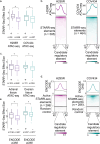Gene regulatory activity associated with polycystic ovary syndrome revealed DENND1A-dependent testosterone production
- PMID: 40825976
- PMCID: PMC12361435
- DOI: 10.1038/s41467-025-62884-7
Gene regulatory activity associated with polycystic ovary syndrome revealed DENND1A-dependent testosterone production
Abstract
Polycystic ovary syndrome (PCOS) is among the most common disorders affecting up to 15% of the menstruating population globally. It is the leading cause of anovulatory infertility and a major risk factor for type 2 diabetes. Elevated testosterone levels are a core endophenotype. Despite that prevalence, the underlying causes remain unknown. PCOS genome-wide association studies (GWAS) have reproducibly mapped a number of susceptibility loci, including one encompassing a gene regulating androgen biosynthesis, DENND1A. Identifying the causal variants within these loci will provide fundamental insight into the precise biological pathways that are disrupted in PCOS. Here, we report the discovery of gene regulatory mechanisms that help explain genetic association with PCOS in the GATA4, FSHB and DENND1A loci using a combination of high throughput reporter assays, CRISPR-based epigenome editing, and genetic association analysis from PCOS case and control populations. In addition, we find that increasing endogenous DENND1A expression causes elevated testosterone levels in an adrenal cell model, specifically by perturbing candidate regulatory elements. These results further highlight the potential for combining genetic variant analyses with experimental approaches to fine map genetic associations with disease risk.
© 2025. The Author(s).
Conflict of interest statement
Competing interests: The authours declare no competing interests.
Figures





References
-
- Rubin, K. H., Glintborg, D., Nybo, M., Abrahamsen, B. & Andersen, M. Development and Risk Factors of Type 2 Diabetes in a Nationwide Population of Women With Polycystic Ovary Syndrome. J. Clin. Endocrinol. Metab.102, 3848–3857 (2017). - PubMed
-
- Brakta, S. et al. Perspectives on Polycystic Ovary Syndrome: Is Polycystic Ovary Syndrome Research Underfunded?. J. Clin. Endocrinol. Metab.102, 4421–4427 (2017). - PubMed
MeSH terms
Substances
Grants and funding
LinkOut - more resources
Full Text Sources
Medical

